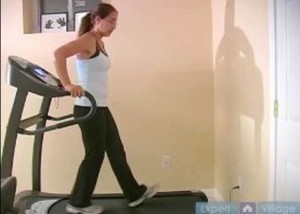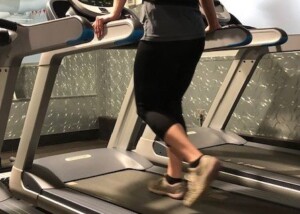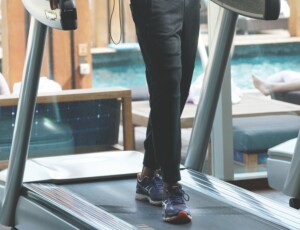
You can relieve your low back pain by walking backwards on a treadmill…
…but if you hold on, you’ll sabotage this benefit!
You need to stand upright and keep your hands off the rails.
Walking backward on a treadmill can relieve low back pain, says a study (Journal of Exercise Physiology online (Vol 14, No. 2, April 2011).
The JEP’s summary includes: “The results support backward walking to reduce pain and increase low back range of motion for athletes with LBP.”
Though the study was conducted on athletes, namely NCAA Division 1, this doesn’t mean that in order to reap the benefits of backward walking for your low back pain, that you must be a collegiate athlete.
“Walking backwards helps to strengthen the quads, calves and glutes,” says Dr. Tom Carpenter, whom I interviewed for this article.
Dr. Carpenter is a corrective exercise specialist, certified personal trainer and chiropractor, inventor of Stand Corrected™, a portable harness-like stretching tool that helps alleviate back, neck and shoulder pain.
“These muscles help to improve balance and posture in general, but specifically, the quads and glutes contribute to stabilizing the pelvis as well,” continues Dr. Carpenter.
“The pelvis is the foundation for the lumbar spine and lower back muscles.
“By improving the proper tone and balance to these muscle groups, the very important pelvic alignment is supported, contributing to a healthier lower back.”
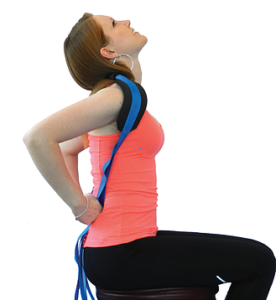
Stand Corrected™
I’ve encouraged my personal training clients to walk backwards on a treadmill for several reasons including alleviation of back pain.
Athletes may have been chosen for the JEP study simply because they can quickly adapt to walking backwards, versus the general non-athletic population.
I’ve had my non-athlete clients walk backwards on a treadmill without any problem, including a middle-age, obese woman with osteoarthritis in her knees.
About 80 percent of people with low back pain do not show, via imaging results or diagnostic tests, any specific pathologies that can explain the low back pain.
Even a very fit athlete can experience low back pain upon bending over to reach into the back of a refrigerator (I actually knew a firefighter-in-training who experienced this).
For the JEP study, subjects were given a pretest which included getting used to walking backwards on a treadmill without holding on.
Not holding on is very important because this forces the body to move in a natural pattern.
On the other hand (no pun intended), placing your hands on the rails cancels out the benefits of a hands-free movement and produces an unnatural, inefficient posture.
The pretest had the subjects walking backwards without knowledge of the speed, which was gradually increased until they said they could no longer comfortably handle whatever speed they were at (without holding onto the rails, of course).
The control group was “healthy active individuals” who did not have low back pain.
After the pretesting period, the subjects then walked backward on a treadmill three times a week, for 15 minute sessions, and controlled the speed.
The report states: “…both groups increased velocity, stride parameters, and low back ROM following 3 weeks of backward walking exercise.
It appears that the presence of LBP did not interfere with the ability of participants to adapt to the actions of backward walking. Both groups achieved greater walking velocity…”
ROM refers to range of motion. The report also says: “…all LBP subjects reduced self-reported P and over half significantly increased low back range of motion.
This finding suggests, as has been previously reported (21), that backward walking improves low back flexibility..” And “P” refers to pain.
How does treadmill backward walking relieve low back pain?
The explanation is technical, but the translation is: The joint action when walking backward differs a bit from the joint action of walking forward.
This altered joint action affects the vertebral disc space…in a positive way.
But you don’t need to know how treadmill backward walking relieves low back pain in order to get on a treadmill and just do it.
I have my clients start out very slowly and I stand before them, my feet straddling the moving tread.
This gives them peace of mind, and it’s also a good practice on my part as a fitness professional.
But if you’re alone, start at a very slow speed, say, 1 mph.
Like the study subjects did initially, place hands on the treadmill rails and get positioned with good walking posture. But at some point you must remove your hands.
Otherwise you’ll cause a disservice to your body. Holding on “would negate the normal healthy bone rhythms and core muscle stability that are engaged by not holding on,” says Joseph Ciotola, MD, orthopedic surgeon at The Orthopedic Specialty Hospital at Mercy Medical Center.
Don’t fear falling off; you’re going only 1 mph. Spend as much time as needed getting used to this. It’s supposed to feel different, even awkward.
But you will get used to it. As you get more comfortable, let go of the rails, and just gradually increase speed.
Mimic the research: Walk backwards on the treadmill without holding the rails, three times a week, for 15 minute sessions.
See if this doesn’t help relieve your low back pain, especially if your doctors have not pinpointed the cause via diagnostics.
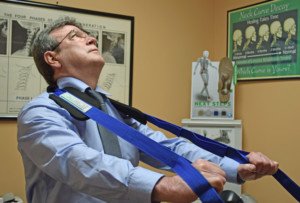
Photo credit: Aleesia Forni
Based upon 30+ years of experience, Dr. Carpenter’s practice approach reflects his belief that restoring optimum health and function will enable his patients to enjoy a much greater amount of vitality and wellness. Chiropractic care is true health care, not sick care!
 Dr. Ciotola is dedicated to providing his patients the best orthopedic care possible for their hip, knee or shoulder pain.
Dr. Ciotola is dedicated to providing his patients the best orthopedic care possible for their hip, knee or shoulder pain.
 Lorra Garrick is a former personal trainer certified through the American Council on Exercise. At Bally Total Fitness she trained women and men of all ages for fat loss, muscle building, fitness and improved health.
Lorra Garrick is a former personal trainer certified through the American Council on Exercise. At Bally Total Fitness she trained women and men of all ages for fat loss, muscle building, fitness and improved health.
.

